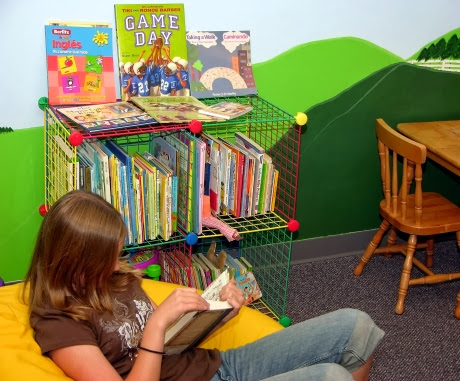
The Montessori lower elementary literacy program uses a blended phonics and literature approach. Preparation for reading and writing begins in the Montessori preschool environment, where the practical life area prepares the child to read and write by strengthening the fine muscles of the hand as well as developing the left-to-right movement necessary for writing and reading.
Montessori Language Arts, From Preschool to Elementary
The sensorial area helps children classify and recognize patterns. And when children begin work in the language area they learn letter sounds before letter names because it is the sounds of the letters that are most important when we write and read. With this approach, children begin writing before they read. Writing is encoding, or putting together sounds that are known, and it is easier than reading, which is decoding, or taking apart to understand meaning. Children are also learning that every word has an important function and that words follow patterns to give meaning to language.
Both the preschool and lower elementary classrooms allow for the child’s spontaneous development of writing. When children are first learning to write, it is more important for them to get words down on the page than to worry about mechanics. And in this early stage, children tend to use a lot of inventive spelling. However, as their writing skills develop, mechanics and standard spelling occur as a natural progression of their practice.

As the child progresses through the phonetic patterns, the teacher introduces them to literature through reading aloud and small group work, such as literature circles. Additional language work, such as learning about abbreviations, prefixes, syllabication, capitalization, and punctuation, is taught using word cards and labels. Children learn grammar by working with the Montessori Grammar Symbols and the miniature environment, which help isolate the concepts of parts of speech. They later progress to working with sentence analysis, analyzing the functions of words within sentences. Vocabulary is built into every aspect of the curriculum through the use of nomenclature cards, which consist of a control card, a picture card, a label or name card, and in lower elementary, a definition card.

- Montessori Education Builds Development Needed Before Reading
- Teacher Tested Suggestions for Montessori Lower Elementary Reading Programs
- Montessori Curriculum Explained: Language Arts Materials, Activities and Philosophy
- Developing Vocabulary in the Montessori Environment
As much as possible, NAMC’s web blog reflects the Montessori curriculum as provided in its teacher training programs. We realize and respect that Montessori schools are unique and may vary their schedules and offerings in accordance with the needs of their individual communities. We hope that our readers will find our articles useful and inspiring as a contribution to the global Montessori community.
© North American Montessori Center - originally posted in its entirety at Montessori Teacher Training on Tuesday, October 29, 2013.
© North American Montessori Center - originally posted in its entirety at Montessori Teacher Training on Tuesday, October 29, 2013.

0 comments:
Post a Comment
Have questions or comments? Let us know what you thought about this article!
We appreciate feedback and love to discuss with our readers further.